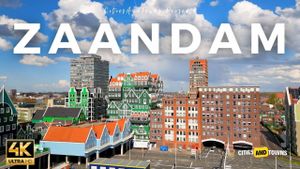'Het Verhaal van Nederland - Amsterdam,' the much-anticipated historical series celebrating the 750th anniversary of the Dutch capital, offers viewers both grandeur and nuance by exploring Amsterdam's rich past. Broadcasted every Wednesday evening at 8:25 PM on NPO 1, this four-part series delves deep to unearth significant yet often overlooked events and figures, reshaping how audiences perceive the city's history.
Central to this production are historians Frans Camphuijsen and Jouke Turpijn, who lend their expertise to bring authenticity to the narrative. Camphuijsen reflects on his involvement, stating, 'Ik werd in eerste instantie gebeld om commentaar te leveren op het script' (I was initially called to comment on the script). He emphasizes the importance of accuracy, correcting misconceptions such as the image of medieval nobles surrounded by vast libraries. 'Boeken waren in die periode ontzettend duur' (Books were extremely expensive during this period), he notes, illustrating the rarity of such settings.
The series captures Amsterdam’s beginnings from 1275, emphasizing the evolution of architectural methods, particularly the ingenious use of pilings to build on marshy ground. This innovation allowed the city to flourish, making it the vibrant metropolis it is today. "De klei vormde de voorbode voor veel drama tot op de dag van vandaag" (The clay heralded much drama even up to today), says narrator Daan Schuurmans, who brings historical scenes to life through his engaging storytelling.
Turpijn plays a significant role as well, adding layers of political and cultural history to the narrative. 'Honderd procent accuraat is gedramatiseerde geschiedenis natuurlijk nooit' (One hundred percent accuracy is never possible with dramatized history), he explains, recognizing the challenges historians face when depicting past events. His passion shines through as he details how the series narrates the stories of lesser-known figures like Samuel Sarphati, whose legacy against poverty remains relevant.
The production caters to a broad audience by intertwining dramatized reenactments with expert commentary. Camphuijsen emphasizes the modernizing effect of focusing on periods often overshadowed by the Dutch Golden Age. He insists, 'Wat we voorheen de Gouden Eeuw noemden, heeft altijd ontzettend veel aandacht opgeslokt' (What we used to call the Golden Age always consumed so much attention), which has led to the neglect of the fascinating pre-Golden Age history.
Episode highlights include the depiction of societal struggles faced by Holocaust survivors post-World War II, drawing connections to the protest culture of the 1960s and 1970s, which is seldom discussed. Turpijn remarks, 'Het had allemaal heel anders kunnen lopen, en daarin is vooral het perspectief van passanten interessant' (It could all have turned out very differently; the perspective of outsiders is particularly interesting).
Throughout the series, viewers gain insights not just from the narratives of powerful men, but also from marginalized voices within the community. The series is unflinching as it explores gentrification, migration, and the diverse elements molding Amsterdam's identity, enriching the viewer's perspective on the city.
According to Schuurmans, the appeal of the show lies not only in its historical accuracy but also within the dramatization's engaging nature. He describes stepping onto battlefields and portraying characters involved vividly, saying, "Ik vond het een voorrecht dat ik dit mag doen" (I find it a privilege to do this). This immersive approach invites viewers to experience history as if they were part of it.
By focusing on the rich, multicultural history of Amsterdam, the series sheds light on the influential roles played by various communities over time. From Sarphati's Jewish background to interactions within the queer community, the depth and interplay of diverse narratives challenge conventional historical accounts.
Finally, the series serves as a reminder of how history is not merely about dates and events; it's about the people who lived it and the myriad experiences they had. Turpijn elegantly concludes, 'De geschiedenis van Amsterdam blijkt diverser dan vermoed' (The history of Amsterdam proves to be more diverse than one might assume). This exploration encourages viewers to appreciate the complex, layered essence of their city's heritage.
For those intrigued by the past, 'Het Verhaal van Nederland - Amsterdam' offers not just entertainment but also enlightenment, drawing connections between history and contemporary society. Engaging storytelling mixed with visual flair makes for compelling viewing, making the series one of the must-watch programs for anyone interested in the fabric of Amsterdam's rich history.



